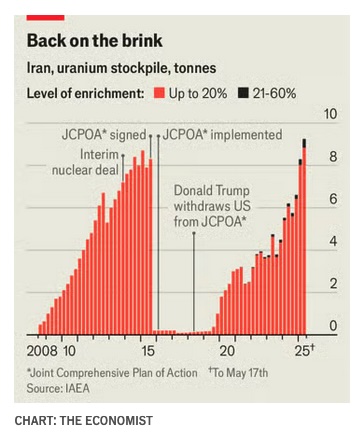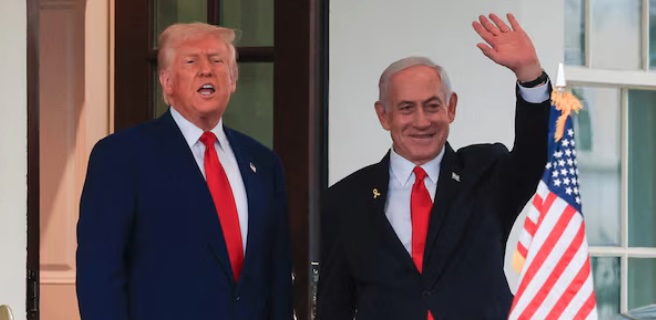In the early hours of June 13, the Israeli Air Force, reportedly aided by special forces/spy units pre-deployed into Iran, launched a barrage of massive strikes against Iranian air-defenses, nuclear facilities, command-and-control nodes, and individual targeted Iranians, military and non-military. Iranian government negotiators were planning to meet in Muscat, Oman, just two days later, in the next phase of the talks that U.S. envoy Steve Witkoff had maintained for the previous two months. (Israel’s attack reportedly killed some of the Iranian specialists who were planning to attend those Muscat talks.)
The Israeli attack almost certainly took the Iranians by surprise. Israel killed many senior military leaders, especially in the elite Iranian revolutionary Guard Corps. But within just a few hours, Iran’s command system proved capable of responding in kind; and since June 13, every night has seen an exchange of deadly missiles between the two countries. Israel has delivered much of its ordnance against Iran from air-force planes flying right over Iran, or close to its Western border in the skies of Iraq and Syria protected by U.S. surveillance (and potential interception) capabilities, while Iran has delivered its missiles, including some hypersonic missiles, from its own home turf.
The Israelis claim they have destroyed many significant Iranian military and nuclear-research facilities. Their attacks– along with calls from Pres. Trump for the “evacuation” of the whole of Tehran–have caused deep disruptions in the lives of millions of Iranians.
The human casualties of this war have been very much higher in Iran than in Israel–though not on a per-capita basis. In Israel, families who have never previously experienced “incoming” attacks that caused more than minor damage have now been seeing the much larger level of damage inflicted by those Iranian missiles that manage to evade Israel’s multi-layered (and partly U.S.-supplied) anti-missile shields.
The two sides have seemingly become locked into a deadly war of attrition with no clear end– or even a plausible diplomatic off-ramp– in sight. (There have meantime been some reports that Israel’s stock of “Arrow” anti-ballistic missiles has been depleting at a rate that can’t be sustained for very much longer.)
Within this picture of a possibly lengthy, slugging-it-out war of attrition, there are a number of possible wild cards:
- One is the much-discussed possibility of the USAF delivering a possibly decisive “death-blow” to Iran’s big uranium-enrichment reserve kept deep underground at Fordo– which would bring about a very real risk of direct Iranian retaliation against U.S. forces stationed nearby (with all the subsequent disruption/escalation that that would entail.)
- A second is the possibility that Israeli and U.S. calls for “regime change” in Tehran might become fulfilled.
- A third is that the non-U.S. powers in the UN Security Council might find a way to reinsert the UNSC into the leadership position regarding international peace and security for which it was expressly designed.
- A fourth would be that Pres. Trump, finally persuaded by that significant corpus within his party that wants to avoid foreign entanglements at all costs, might decide to pull the plug on the very considerable amount of aid, in many different spheres, that he has until now given Israel’s war campaign in Iran.
- A fifth would be a truly “wild” card that I haven’t yet imagined.
Note that these “wild cards” are not all mutually exclusive. I could see a way in which numbers one, three, and four might all be combined. Pres. Trump might, for example, attack Fordo with the plan that he would thereupon call “Time” on Netanyahu’s war campaign, and then seek the help of other world leaders to help unravel the whole ghastly situation that his attack has created…
(Regarding wild card two there, the recent, deeply informed assessments of Lior Sternfeld and Arash Azizi that regime change in a period of external attack is extremely unlikely seem very persuasive.)
Netanyahu’s Friday-the-13th launching of his long-sought “big attack” against Iran is inextricably linked to his continued and super-cruel pursuit of the genocide in Gaza.
Ever since October 7, 2023, I have pointed out that one of the most serious impacts of the Hamas-led breakout action of that day was that, within just a few hours, it led to the complete collapse not just of the operational capabilities of the Southern Command of Israel’s long-vaunted military but also of Israel’s entire strategic stance of unchallengeable “deterrent capability” itself. And ever since October 7, 2023, Netanyahu– who was responsible in good part for the Israeli failures of that day– has been scrabbling ever harder and harder to try to re-establish the “credibility” of that deterrence.
In the 20 months since October 2023 that scrabbling to re-establish deterrence, and the continuing complexities of Israel’s deep-seated (and deeply resented in Israel) reliance on U.S. support, have between them led Netanyahu and his government into ever-broader circles of violence throughout ever-broader areas of West Asia.
Back in October 2024, I wrote about how Netanyahu and his government, ever eager to retain the support of Washington for the ongoing genocide in Gaza– or at least, to prevent any effective U.S. action to halt it— had mounted a series of blatant protection rackets in order to keep Joe Biden’s Washington firmly on side. And those protection rackets (acting in concert with the Democratic Party mainstream’s strong and longheld support for Israel) certainly worked.
They continued to work even at the cost of losing the Democratic Party the presidential election last November.
So then, in January, into the White House came Trump. He came in seeming to be more prepared than Biden to push for U.S. interests even in the face of Israeli intransigence. In the crucial January 15 meeting that Trump envoy Witkoff held with Netanyahu, Witkoff forced Netanyahu to finally sign off on the fairly complex, 18-week ceasefire-and-hostages deal that Biden’s people thought they had nailed down between the parties back in May of last year but that Netanyahu then reneged on.
And starting one day before Trump’s inauguration, the first six-week stage of that ceasefire agreement went (almost flawlessly) into operation . Trump then sent his dedicated “hostage negotiator” Adam Boehler to Qatar to nail down the details of the next 6-week phase of the agreement directly with the Hamas leaders.
It could, and should, have happened. But Netanyahu had other plans. When that first six weeks of ceasefire came to a close, Netanyahu closed the whole ceasefire/hostages process down, completely– along with all of Gaza’s borders. And as we know, on March 15, he sent his army and air force once again into a sustained attack against the Resistance and the people of Gaza.
This time around, with Trump, Netanyahu hasn’t even needed to mount anything like the protection rackets of 2024. Trump, unlike Biden, has never been at all susceptible to claims that he ought to, you know, show some concern for the lives of Palestinians, or for international law.
There is quite a lot of evidence that, from late last year, Netanyahu and his generals were already starting to do concrete planning for that same “big one” against Iran that throughout most of 2024 had functioned mainly as the still-distant chimera/threat used to motivate the other, closer-to-home protection rackets.
Back in September-October last year Netanyahu and his generals and his Mossad had completely defanged Hizbullah, whose rockets had since 2000 been a key part of the deterrent that Tehran could wield against possibility of an Israeli attack. Then in December, with the help of Turkey and the many US-supported forces working for “regime change” in Syria– and with some quiet, general support from Russians– the Israelis succeeded not only in ousting Syria’s Pres. Asad but also in destroying all the remaining significant capabilities of Syria’s armed forces.
The Israeli Air Force could thenceforth rule Syria’s skies quite freely; and with the active help of the U.S. military bases in northeast Syria and in northern Iraq, its air-route to Iran was now quite open. Israeli special forces could probably also find ground-routes along that corridor, or from Azerbaijan, to get their Ukrainian-style “Spiderweb” trucks into position inside Iran…
The desire of Israeli leaders to periodically demonstrate the “ingenious” and “far-reaching” capabilities of their military is motivated not just by a desire to exert a “deterrent” capability against potential adversaries. It is also motivated by a desire to prove, over and over again, the Israeli military’s value as tip-of-the-spear strike forces on behalf of the dominant imperial power, in order to keep the political support of that imperial power for the ongoing Zionist project in Palestine at the highest possible level. (For the Zionists seeking Western imperial support, it was ever thus, from the days of Chaim Weizmann on.)
That value of Israel’s military/strategic capabilities had been deeply dented– almost vaporized!– on October 7, 2023. But today, Netanyahu and his government are saying to the whole world: We’re back!
And at least one of Trump’s key generals, Centcom head Gen. Michael Kurilla, seems to have bought the Israeli KoolAid and to think that Israel’s demonstrated strike power against Iran can be good for U.S. interests. Kurilla visited Israel in an official capacity in July, September, and December of last year and was the commander who, over these past weeks, oversaw all the close coordination needed to ensure the safety, security, and safe refueling (by U.S. planes, over Syria) of the Israeli Air Force planes flying repeated sorties over Iran…
Thus far, and wisely, the Iranians have chosen not to react to the U.S. military’s active support of Israel’s attack planes by striking back at any of the numerous U.S. military facilities strung out very close at many points to Iran’s land and sea borders. If the U.S. engages directly to bomb Fordo, or any place else inside Iran, then all bets would be off.
And at that point a truly massive international crisis would ensue, one that might indeed see the other, non-‘Western’ powers of the world finally step up to challenge Washington’s desire the continue dominating (and monopolizing all international diplomacy regarding) that portion of the earth’s surface that lies in West Asia, sometimes known as the “Middle East.”
We will see. Pres. Trump has said he’ll make a decision on bombing or not bombing Fordo “within two weeks.” There is a very significant cleavage within his own governing party over this issue.
Meantime, there have been reports today that some of the B-2 bombers the USAF would need to carry GBU-57 “bunker buster” bombs into action against Iran have started to fly from Missouri toward the crucial Indian Ocean staging point in Diego Garcia…
Meantime, Israel’s genocide in Gaza continues. (Though it has been almost completely chased off the front pages of media worldwide by updates on the ever-escalating crisis over Iran.)
Meantime, Israeli or Israel-supported mayhem continues to devastate the lives and communities of people in the West Bank, in Lebanon, and southern Syria.

Meantime, almost nobody in the world gives any credence at all to the hastily-cobbled-together “reasons” the leaders in Israel and Washington have given for the “necessity” of instant and decisive action against Iran. After 20 months of non-stop Israeli lies over Gaza, the credibility of Israeli spokesmen– or their acolytes in Washington– on matters regarding Iran and its nuclear program is near zero. (See the chart here from the IAEA, via the Economist.)
Today, what the vast majority of people and leaders around the world see is Israel’s naked use of cruel and bullying destructive force against another sovereign state.
Will the big roll of the dice against Iran that Netanyahu and his government launched against Iran on June 13 end up bringing the whole of the US-Israeli power machine in West Asia crashing down?
We will see.


